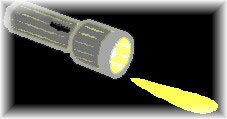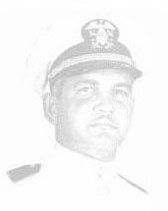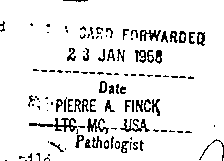 Dark Corners Menu |
 Pitzer Main Page |
 Dark Corners Menu |
 Pitzer Main Page |
 |
by Allan R.J. Eaglesham |
|
In an article published in the January 1998 edition of JFK/DPQ, The Untimely Death of Lt. Cmdr. William Pitzer, Robin Palmer and I presented a summary of recently released information that indicates that William Pitzer did not commit suicide, at odds with official rulings from investigations of his death by the FBI, the Naval Investigative Service, and an Informal Board of Investigation set up by the Commanding Officer of the Naval Medical School. Despite this copious new information, many questions remain, including the most fundamental: who pulled the trigger, and why? This article is an attempt to weave some of the loose ends into a plausible tapestry.
Pitzer's untimely passing (on 29 October 1966, at Bethesda Naval Hospital) is one of some forty that constitute the "mysterious deaths" of people directly or indirectly associated with the assassination of President Kennedy. In their book JFK; The Dead Witnesses (1995, Consolidated Press International, Tulsa, pp. 40-41), John Armstrong and Craig Roberts described Pitzer's demise as "one of the strangest cases of 'suicide' in the history of the Kennedy assassination." Pitzer is linked to the JFK assassination via Dennis David, a friend, naval colleague and prot�g� of Pitzer's, who maintains that he saw in his mentor's possession black and white photographs, color slides and, most significantly, movie film exposed during President Kennedy's autopsy, within a few days of the assassination. Therefore, if, as the recently released evidence suggests, William Pitzer did not commit suicide, then the truth was covered up by two naval investigations and by the FBI, with far-reaching implications. A suspicious aspect of the case is that the Pitzer family was denied the autopsy report for more than two decades. When eventually it was released to them in the late 1980s, it revealed that, in conflict with what Mrs. Pitzer had been told by naval officials, there was no injury to the deceased's left hand; her request for her husband's wedding ring had been denied in those terms - she was told that his left hand was too badly injured to permit removal of that most precious item. Why would the Navy deny this request? There are two likely possibilities: they did not have the ring because it had been stolen, or it was damaged in a way that was inconsistent with the official ruling of suicide. With assistance from lawyer James Lesar, President of the Assassination Archives and Research Center, author Harrison Livingstone obtained access to part of the Pitzer autopsy report that describes the bullet wound to the right temple; the absence of powder burns led Mr. Livingstone to theorize that the wound was not self-inflicted (High Treason 2, 1992, Carroll & Graf, New York, p. 558). On the other hand, a gun held tightly to the skin at discharge does not result in the "tattooing" that is characteristic of a close-range shot. Mr. Livingstone succeeded in obtaining the Navy's Informal Board of Investigation Report into Pitzer's death. That document deduces suicide on the basis of the deceased's overwork and personal problems. There is little reference to, and no discussion of, the physical evidence gathered and analyzed by the FBI and the Naval Investigative Service that should have constituted the clear and irrefutable proof that a career naval officer of exemplary record had taken his own life. Two aspects of the newly released FBI information are particularly puzzling: the conflicting descriptions of the wounds, and the role possibly played by an enlisted man whom Pitzer had helped through psychiatric problems. In this article I will draw inferences concerning these aspects and I will reveal intriguing new information that further suggests a link with the Kennedy assassination. THE WOUNDS "... the gun could have been very close to the head, but not touching it but so close there would have been no time for the powder to have spread out after leaving the muzzle and thereby leaving no outside indicating (sic) of splatter burn or imbed (sic) powder particles around the wound." For now, let us accept this explanation: no powder tattooing, no muzzle mark, nevertheless a close shot consistent with suicide, or, to use Lt. Cmdr. Lowsma's phraseology, "not inconsistent" with a self-inflicted wound. In contrast with the pathologists' written and verbal statements, the Deputy Medical Examiner for Montgomery County, Dr. J.G. Ball, told the FBI that he observed muzzle marks and powder burns around the wound. Dr. Ball stated that he received a call at approximately 8:50 PM and arrived at the Bethesda Naval Hospital at 9:15 PM. He did not examine the wound in the head until 11:30 PM, however. Why the delay of over 2 hours - was there a jurisdictional dispute perhaps, with certain people at the scene uncomfortable with Dr. Ball's presence? The FBI reported Dr. Ball's statement as follows: "From his observations of the situation in the room at the time he first observed it, and after having been advised that things were in the same condition as when the body was found, he concluded that Pitzer was probably sitting in a chair and shot himself in the head with the pistol..." The preamble to Dr. Ball's conclusion indicates that he harbored misgivings at what he observed, since he apparently sought assurance that "things were in the same condition." The naval Medical Officer on duty that evening, Lt. Cmdr. R.W. Steyn, viewed the body just minutes after its discovery, and stated as follows on the Naval Death Certificate: "A left temple wound was visible, the right side of the head being hidden, lying in a pool of coagulated blood." Lt. Cmdr. Steyn seems to be implying that the wound in the left temple would have a counterpart on the right side of the head to explain the death and the copious accumulation of blood. Just as Dr. Ball failed to define the specific location of the wound bearing the tattooing and muzzle marks, the pathologists failed to mention in the autopsy report the wound in the left temple that was described by Lt. Cmdr. Steyn in the Naval Death Certificate. In his statement to the FBI, pathologist Harmeling stated: "There was no evidence of powder burns on the right side of the head where entry was made..." Does this careful wording imply that such burns were present on the left side of the head, from a non-entry wound? There is a surprising and controversial aspect of the autopsy report: the pathologists described three defects in the skull. Two were associated with the bullet traversing from right to left, the other, the largest, approximately 11/4 x 1/2 inches, is described only in the briefest of terms. On the covering page of the autopsy report are the following notations: "Puncture wound, skull, right temporal bone (entrance) and in the section describing the head: "After removal of the brain a third defect in the bony skull is encountered. This consists of a large defect in the left supra-orbital plate measuring 3.0 x 1.0 cm." It appears that this defect had no counterpart in terms of damage to the underlying brain or to the overlying skin. But, most significantly, "supraorbital plate, sphenoid bone, left" means "left temple," the location of the wound described in the Naval Death Certificate by Lt. Cmdr. Steyn. The following hypotheses bring unity to these apparently conflicting observations:
A non-penetrating tangential shot provides a possible explanation for another anomalous aspect of the physical evidence. A blackboard at the scene was struck by a bullet: "...as revealed by analysis of residual metal particles in the indentation." Apparently, this was a source of puzzlement for the investigating officers. Given the locations of the corpse, revolver, spent bullet, and blackboard, there had to have been another point of ricochet: "Extensive examination of the scene failed to determine what the projectile struck resulting in the extensive indentation." The spent slug found close to the deceased had bone particles adhering to it, whereas the blackboard indentation had no such residue. I infer that the blackboard was struck by the non-fatal shot to the left temple, and, because that bullet did not pass through the skull, but hit it tangentially, it left no bone residue on the indentation. THE ENLISTED MAN Therefore, Bill Pitzer's violent demise might have had no connection with possession of photographic materials of the Kennedy autopsy - it may have resulted from some bitter personal dispute. However, the fact that the FBI and the Navy covered up this crime is powerful indication that something more sinister was involved than personal animosity. I offer the following unifying hypotheses as subject for discussion: Statements written and spoken by Pitzer in the days before his death may be interpreted as indications that he was considering suicide. Equally valid is the possibility that he was considering his own mortality because he felt under threat. There is an interesting, and possibly relevant passage in the statement of a colleague who had accompanied Pitzer on recent business trips to Florida. As written by the questioning FBI agent: "Commander PITZER took [redacted] both trips he made to Pensocola [sic], Florida, with Commander PITZER. The reference to "the gun" indicates that the redacted words refer to a firearm. The colleague is then quoted by the FBI as follows: "He knew Commander PITZER had a gun which he kept in his brief case and this gun was used as a training aid during lectures." The reference here to "this gun" suggests that William Pitzer had two firearms in his possession when he traveled afield - one as a teaching prop, and the other possibly because he felt vulnerable. [Note added 23 July 2,000: I am now certain that the highly redacted section, part of which is shown in this link did not pertain to the enlisted man. The second paragraph applied to the enlisted man, and I was in error in thinking that the same man was the subject of the third paragraph. Neither did this redacted section pertain to William B. Pitzer himself; however, the purpose of the subject matter of this highly redacted section was to add weight to the theory that he committed suicide because of stress.] A FINCK LINK 
How intriguing - Lt. Col. Finck, participant in the Kennedy postmortem, has inspected the autopsy records of William B. Pitzer. Is it possible that he was boning up in preparation for being called as a witness at the trial of Clay Shaw? We will probably never know. CONCLUSION If/when there are any further developments, we will communicate them to the JFK/DPQ readership.
|